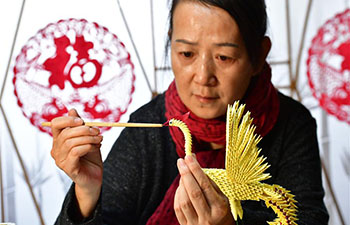WASHINGTON, Jan. 3 (Xinhua) -- American scientists reported that tiny tube-like protrusions called primary cilia on cells of the retinal pigment epithelium (RPE) -- a layer of cells in the back of the eye -- are essential for the survival of the retina's light-sensing photoreceptors.
The discovery, newly released on Cell Reports, advanced efforts to make stem cell-derived RPE for transplantation into patients with dry age-related macular degeneration (AMD), a common disease for the old people in both America and China.
"We now have a better idea about how to generate and replace RPE cells, which appear to be among the first type of cells to stop working properly in AMD," said Kapil Bharti, the study's lead investigator at the National Eye Institute, part of the U.S. National Institutes of Health (NIH).
In a healthy eye, RPE cells nourish and support photoreceptors, the cells that convert light into electrical signals that travel to the brain via the optic nerve. In AMD, RPE cells die, which causes photoreceptors to degenerate, leading to vision loss.
Bharti and his colleagues are hoping to halt and reverse the progression of geographic atrophy by replacing diseased RPE with lab-made RPE. The approach involves using a patient's blood cells to generate induced-pluripotent stem cells that are capable of becoming any type of cell in the body.
But in an attempt to create functional implants, RPE cells always get developmentally stuck, Bharti said.
"The cells frequently fail to mature into functional RPE capable of supporting photoreceptors. In cases where they do mature, however, RPE maturation coincides with the emergence of primary cilia on the iPSC-RPE cells," Bharti said.
The researchers tested two drugs known to enhance cilia growth and they significantly improved RPE's structural and functional maturation and the cells performed a crucial function of mature RPE cells -- they engulfed the tips of photoreceptor outer segments, a pruning process that keeps photoreceptors working properly.
By contrast, stem cell-derived RPE cells exposed to an inhibitor of cilia growth, demonstrated severely disrupted structure and functionality.
The report suggests that primary cilia regulate the suppression of a cell signaling pathway involved in embryonic development. Suppression of the pathway called WNT instructs the cells to stop dividing and to begin differentiating into adult RPE, according to the researchers.
Bharti is leading the development of patient stem cell-derived RPE for an AMD clinical trial set to launch in 2018.

















